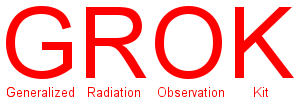 | One step closer to grokking patient radiation dose. |
GROK is an open source (download source code) pure Java toolkit for extracting CT exposure metrics from a DICOM image archive. Binary distribution also available.
GROK was developed by a team of radiologists and other medical imaging informatics professionals involved with radiation dose research at the Center for Evidence Based Imaging at Brigham and Women's Hospital in Boston, MA. More details about the scientific research using GROK, including presentations and publications, can be found at the CEBI GROK site.
It is derived from David Clunie's open source PixelMed Java DICOM toolkit and related Dose Utility application.
GROK extracts CT dose information from legacy dose report screens, including the anatomy irradiated at the dose-event level expressed in a standard (SNOMED-CT) terminology, and generates a database of the extracted information. It is also capable of creating DICOM CT Radiation Dose Structured Reports (RDSRs).
Experimental support for automated patient body habitus quantification, in equivalent centimeters of water diameter, based on image attenuation is also included.
Features:
(1) Pure Java implementation, can run on most platforms.
(2) Minimal hardware requirements. (1 GB ram, ~1 GB hard disk space recommended)
(3) Supports "legacy" dose screen captures from: GE, Philips, Siemens, and Toshiba.
(4) Native OCR capability. No extra software or OCR integration required.
(5) Directly queries DICOM image archive. No need to separately identify and retrieve dose screens.
(5) Automated extraction of information from *all* CT examinations on archive (e.g., patient name, accession number, manufacturer, scanner name, instituiton name, protocol name, etc.)
(6) For encounters with legacy dose screens, exposure parameters on the dose screen (e.g., CTDIvol, DLP, scan range, tube voltage, tube current, etc.) are also extracted.
(7) Anatomy assignment algorithms add the anatomic region irradiated to each non-topogram irradiation event on dose screens.
(8) Extracted information is recorded in a relational database. (PostgreSQL and Microsoft SQL Server support currently included.)
Requirements:
(1) Computer with Java. (1 GB of RAM and 1 GB hard drive space recommended.)
(2) DICOM image archive containing CT examinations.
(3) SQL database. (Tested with the freely available PostgreSQL 8.4 as well as Microsoft SQL Server 2005.)
(4) GROK. (Includes PixelMed toolkit and associated libraries).

